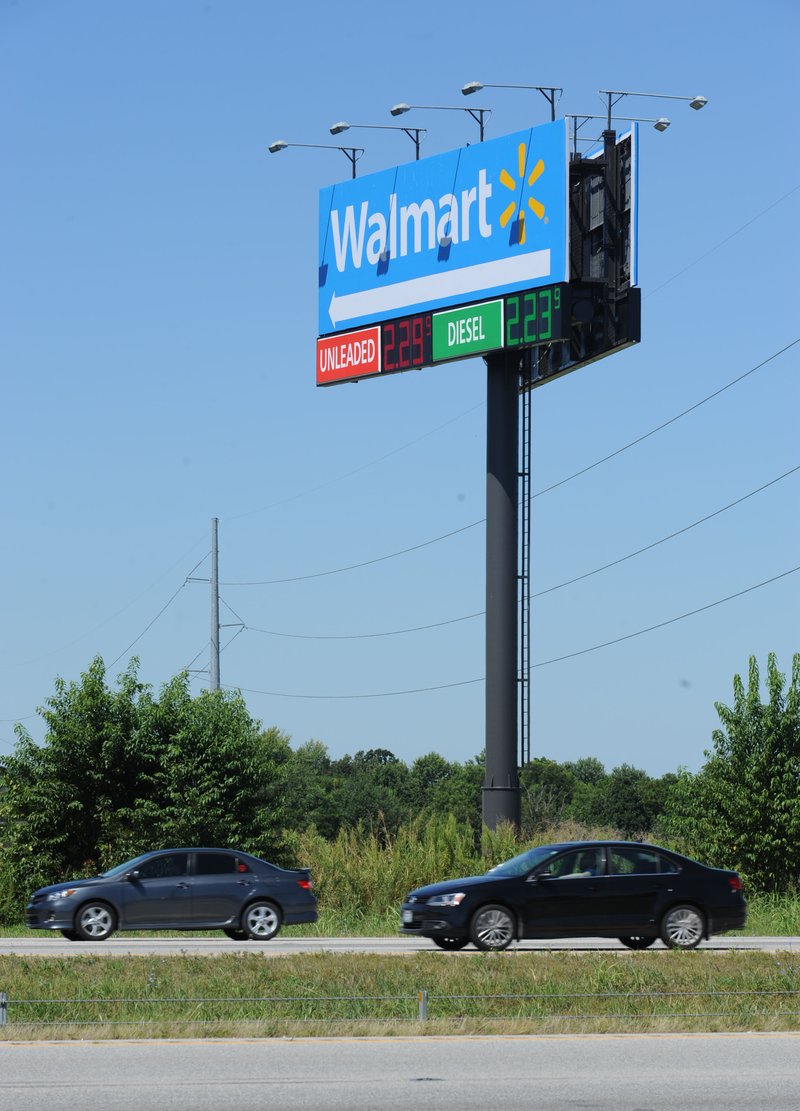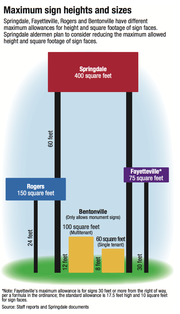SPRINGDALE -- Aldermen are looking to make the city's rules on sign size and height stricter.
Officials discussed the requirements at a City Council committee meeting Aug. 17 and plan to discuss them again Monday. An amendment to the sign ordinance would reduce new signs' maximum height from 60 feet to 30 feet and maximum face from 400 square feet to 150 square feet, according to documents. The current maximums are greater than those allowed in Fayetteville, Rogers and Bentonville.
WEB WATCH
To view the part of Springdale’ code of ordinances pertaining to signs, go to municode.com, hover over “CODE LIBRARY,” click on “ARKANSAS” in the menu that appears and click on “Springdale.” Then scroll down the list on the left side of the screen and click on “Chaper 98 - SIGNS.”
The reason for the proposal to reduce the maximum sizes is mostly aesthetics, said Mike Chamlee, chief buildings official with the city's building department. A lot of signs can clutter a landscape. Lower signs also aren't as intrusive when motorists are driving through, he said.
Signs that exceed the proposed maximum sizes would be grandfathered in, Chamlee said. They would have to come into compliance if the property goes more than six months without an active licensed business. It's also possible a sign would have to be brought into compliance if there's a change in use for the property, he said.
A property owner could also apply for a variance, Chamlee said.
The city also has a "special visibility district" on Sunset Avenue around Interstate 49, where signs can be a maximum of 100 feet tall, Chamlee said. The possible changes in the city's code of ordinances would not affect sign heights in this district.
Alderman Mike Overton said he's in favor of reducing the sign height and face maximums in Springdale. The goal is to try to clean up the city, he said.
"Currently, we look like a bazaar," he said.
Mayor Doug Sprouse said he thinks reducing the maximum sizes is a good idea for new signs. He also said it's important not to put Springdale businesses at a disadvantage.
Sprouse said he thinks lowering the maximum sizes can improve aesthetics in parts of the city. Old signs will be changed out for new ones and as new businesses come in with new signs, he said.
It's too early in the process to say how the changes would affect businesses in the city, said Bill Rogers, vice president of communications and special projects for the Springdale Chamber of Commerce.
Bentonville has perhaps the strictest sign regulations compared to Springdale, Rogers and Fayetteville. Bentonville's City Council approved an ordinance in 2011 requiring new and replacement free standing signs in the city to be monument-style signs, said Shelli Kerr, planning services manager.
One reason for the monument signs is safety, said Troy Davis, a code enforcement officer for the city. Officials wanted to require that signs be at eye level for drivers, Davis said. This helps because drivers don't have to look up at signs.
The other reason is so trees don't block signs, Davis said. A pole sign could be blocked by a tree, while a property owner can trim lower vegetation so it doesn't block a monument sign, he said.
Bentonville still has pole signs grandfathered in, Davis said. Pole signs are typically brought into compliance if a property redevelops, a sign becomes dilapidated or a property owner wants to enlarge the area of a sign's face, said Beau Thompson, a senior planner for the city.
A property owner could also apply for a variance to put up a pole sign, Thompson said. State statute requires the applicant to prove a hardship.
The item Springdale aldermen will discuss at Monday's City Council committee meeting isn't the first sign-related topic aldermen have addressed this year. On June 9, the City Council approved an amendment to the city's code of ordinances concerning abandoned and unsafe signs. The changes clarified the process for removing signs, said Ernest Cate, city attorney, at the time.
The new process is simpler and similar to the steps for removing a blighted building, said Patsy Christie, city director of planning and community development, at the time.
The maximum sign height and face requirements would apply to freestanding signs in downtown, planned commercial, general commercial, thoroughfare commercial, large product retail sales district, warehouse, light industrial, heavy industrial and planned industrial zones in the city, according to documents.
NW News on 08/30/2015


